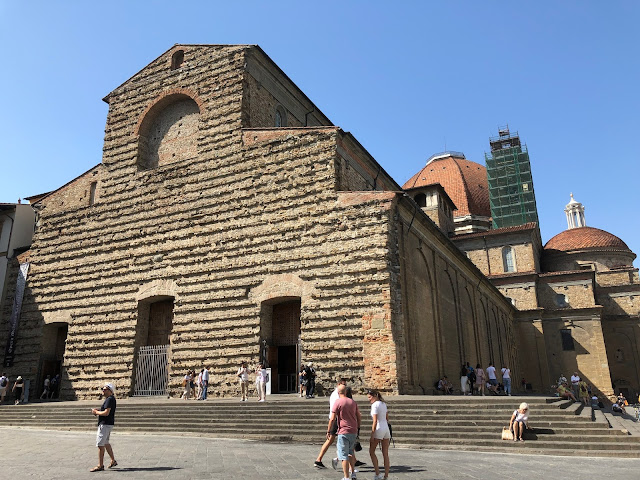【フィレンツェ】サン・ロレンツォ教会 Firenze - San Lorenzo
サンタ・マリア・デル・フィオーレ大聖堂から北西に少し歩いた場所に、サン・ロレンツォ教会がある。
この場所にはずっと古い教会の跡が残っていたが、1418年からメディチ家のジョバンニ・ディ・ビッチにより再建が始められた。
その後再建は中断されたが、ジョバンニの子であるコジモに引き継がれた。この教会は、メディチ家と深い関係にあり、その菩提寺とも言われている。
教会全体の設計はブルネレスキが担当した。ルネサンス建築を代表する建物の一つになっている。
ブルネレスキは1446年に亡くなり、その後は別の建築家に引き継がれたが、正面のファサードはミケランジェロに依頼された。
ミケランジェロは、その表面の様々な彫刻を飾ることができる、長方形のファサードを設計したが、その工事は行われずに、現在に至るまでファサードは未完成のまま残されている。
A short walk northwest of the Cathedral of Santa Maria del Fiore is the Church of San Lorenzo.
The site had a long-standing remains of a church, which was rebuilt in 1418 by the Medici Giovanni di Bicci.
After that, the reconstruction was interrupted, but it was taken over by Cosimo, the son of Giovanni. This church has a close relationship with the Medici family and is also known as its family temple.
Brunelleschi was in charge of designing the entire church. It is one of the representative buildings of Renaissance architecture.
Brunelleschi died in 1446 and was subsequently taken over by another architect, but the front façade was commissioned by Michelangelo.
Michelangelo designed a rectangular façade that could be decorated with various sculptures on its surface, but no construction was done and the façade remains unfinished to this day.
教会の内部はとても広く、外光も十分に取り入れられていて、敬虔さの中にも開放的な雰囲気に溢れている。
白い壁と灰色の柱などの石材の色が美しく、床にもその2色が取り入れられているので、空間全体がその2色で統一されている。
The interior of the church is very large, with plenty of outside light, and there is an open atmosphere in piety.
The colors of stones such as white walls and gray pillars are beautiful, and the two colors are incorporated into the floor, so the entire space is unified with those two colors.
この教会には、ドナテッロの最晩年の作品がある。キリストの受難と復活を表現した2つの説教壇だ。
ドナテッロはコジモに愛された彫刻家だった。コジモは自分の死後、ドナテッロが安心して暮らせるように、遺言でドナテッロに農場を残している。
この2つの説教壇は祭壇の近くに、対称になる位置に置かれていて、左の説教壇には、磔にされるキリストなど、キリストの受難の物語が表現されている。
This church has the works of Donatello's last years. Two pulpits that express the suffering and resurrection of Christ.
Donatello was a sculptor loved by Cosimo. Cosimo has left a farm in Donatello in his will so that Donatello can live with peace of mind after his death.
These two pulpits are placed symmetrically near the altar, and the pulpit on the left tells the story of Christ's suffering, such as Christ being crucified.
反対の右側の説教壇には、キリストの復活が描かれている。
キリストが埋葬された墓から聖骸布をまとまった表れて、支持者たちに囲まれるまでのシーンがその一面にアニメーションのように描かれている。
キリストの姿は、老人のように弱々しく、自ら体に鞭打ってようやく立ち上がったかのよう。
ドナテッロ自身も、すでに最晩年にあり、まるで自らの姿を重ねているように見えてしまう。
この説教壇を完成させてから間もなく、1466年にドナテッロは亡くなり、このサン・ロレンツォ教会にあるコジモの墓の隣に埋葬された。
The pulpit on the opposite right side depicts the resurrection of Christ.
The scene from the tomb where Christ was buried to the appearance of a shroud of Turin and being surrounded by his supporters is depicted in an animation on one side.
The figure of Christ is as weak as an old man, as if he had finally stood up by whipping himself.
Donatello himself is already in his last years, and it looks as if he is overlapping himself.
Shortly after completing the pulpit, Donatello died in 1466 and was buried next to Cosimo's tomb in the church of San Lorenzo.
ブルネレスキ、ドナテッロなどのコジモに所縁の芸術家たちの作品が並ぶこのサン・ロレンツォ教会には、やはりコジモに愛されたフィリッポ・リッピの受胎告知がある。
リッピは修道士僧だったが、50歳近くになって若い修道女のルクレツィアを孕ませてしまったことから告発され、彼の才能を愛したコジモの取りなしによって、還俗を許されている。
この受胎告知は1437年から1441年にかけて、リッピの30代の前半に描かれたもので、やや強調された遠近法が使われている。
天使ガブリエルから受胎を告げられるマリアの顔は、うら若き乙女の表情のようには見えない。
リッピはこの作品を描いた頃はルクレツィアとは出会っていなかった。それが原因かもしれない。
In this church of San Lorenzo, where the works of artists related to Cosimo such as Brunelleschi and Donatello are lined up, there is a notice of the conception of Filippo Lippi, who was also loved by Cosimo.
Lippi was a monk, but he was accused of having a young nun, Lucrezia, near the age of fifty, and was allowed to repatriate by the intercession of his talented Cosimo.
This announcement of conception was drawn from 1437 to 1441 in Lippi's early thirties and uses a slightly emphasized perspective.
Maria's face, when the angel Gabriel announces her conception, does not look like the expression of a young maiden.
Lippi hadn't met Lucrezia when he painted this piece. That may be the cause.
アーニョロ・ブロンズィーノの聖ラウレンティウスの殉教。
ブロンズィーノは、フィレンツェ公コジモ1世の宮廷画家をつとめ、やはりメディチ家とは関係が深い芸術家の一人。
ブロンズィーノはマニエリスムの画家としても知られているが、この作品はミケランジェロのシスティーナ礼拝堂の最後の審判へのオマージュに満ちた作品になっている。
背後の建物の表現は、ラファエロの描いた建築表現を意識しているようだ。
Martyrdom of Saint Laurentius of Anyoro Bronzino.
Bronzino is a court painter of Cosimo I, Duke of Florence, and is one of the artists who has a close relationship with the Medici family.
Bronzino, also known as the Mannerist painter, is a homage to Michelangelo's Sistine Chapel's Last Judgment.
The expression of the building behind seems to be conscious of the architectural expression drawn by Raphael.
教会の建物を出ると、ブルネレスキ美しい中庭が現れる。
サン・マルコ修道院の中庭の雰囲気によく似ている。その庭は、ブルネレスキの弟子と言われる、ミケロッツォが設計している。
グラナダのアルハンブラ宮殿のような、イスラム建築によく見られる中庭のようにも思える。
ブルネレスキは、若い頃にドナテッロとともにローマで古代ローマの建築を研究したと言われているが、イスラム建築についてもどこかで学んだに違いない。
Upon exiting the church building, Brunelleschi's beautiful courtyard appears.
It resembles the atmosphere of the courtyard of the San Marco Monastery. The garden is designed by Michelozzo, a disciple of Brunelleschi.
It also seems like a courtyard often found in Islamic architecture, such as the Alhambra in Granada.
Brunelleschi is said to have studied ancient Roman architecture in Rome with Donatello when he was young, but he must have learned about Islamic architecture somewhere.
(Translated by Google Translate)









コメント
コメントを投稿